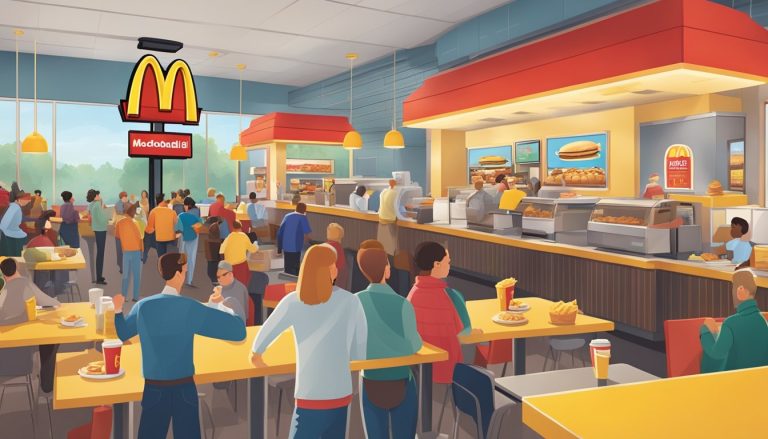McDonald’s hash browns have achieved iconic status in the fast food world. These golden, crispy potato patties are a breakfast favorite for millions. Their perfect balance of crunch and tenderness is no accident, but rather the result of meticulous food science and engineering.
The secret to McDonald’s hash brown perfection lies in their precise blend of potato varieties and innovative cooking process. Up to seven different types of potatoes are used, each contributing unique flavors and textures. The Burbank Russet adds an earthy taste, while the Ranger Russet provides lightness and a golden hue. The Blazer Russet helps create the coveted crispy exterior and fluffy interior.
The potatoes undergo a carefully controlled preparation. They are washed, peeled, and cut into uniform pieces. A blanching step removes excess starch, setting the stage for the ideal texture. The shaped patties are then par-fried and flash-frozen before their final cooking in restaurants. This multi-step process ensures consistency and quality in every bite, delivering the signature McDonald’s hash brown experience that customers crave.
Historical Context of McDonald’s Hash Browns

McDonald’s introduced hash browns to their breakfast menu in 1977. This addition came as part of the company’s broader push into the morning meal market.
The breakfast menu expansion began in 1971 with the Egg McMuffin. Its success prompted McDonald’s to explore more breakfast offerings.
Hash browns were a natural fit for the fast-food chain. They provided a crispy, potato-based side dish that paired well with other breakfast items.
The introduction of hash browns helped solidify McDonald’s position in the competitive breakfast market. It offered customers a familiar and satisfying option alongside their morning coffee.
McDonald’s hash browns quickly became a fan favorite. Their unique shape and crispy texture set them apart from traditional diner-style hash browns.
Over the years, the recipe has remained largely unchanged. This consistency has contributed to their enduring popularity among McDonald’s customers.
The hash browns have become an iconic part of McDonald’s breakfast menu. They are now available in McDonald’s restaurants worldwide, with slight variations to suit local tastes.
Understanding Hash Browns

Hash browns are a beloved breakfast staple, prized for their crispy exterior and soft interior. Their popularity stems from their simple ingredients and versatile nature as a side dish or standalone meal.
Defining the Breakfast Staple
Hash browns consist of shredded or diced potatoes that are pan-fried until golden brown and crispy. The name “hash” refers to the chopping or cutting of ingredients, while “brown” describes the cooking process.
These potato-based treats originated in the United States in the 1890s. They quickly became a breakfast favorite due to their satisfying texture and ability to complement other morning dishes.
Hash browns can be shaped into patties or served loose. Some variations include additional ingredients like onions, peppers, or cheese for extra flavor.
Varieties of Potatoes Used
The choice of potato significantly impacts the texture and taste of hash browns. Starchy potatoes like Russets are often preferred for their ability to crisp up nicely while maintaining a fluffy interior.
Other popular varieties include:
- Yukon Gold: Offers a buttery flavor
- Red potatoes: Holds shape well
- Idaho potatoes: High starch content for crispiness
Some restaurants, like McDonald’s, use a blend of up to seven different potato types to achieve their signature taste and texture.
The moisture content of potatoes is crucial. Too much moisture can result in soggy hash browns, while too little can make them dry and tough.
Comparison with French Fries
While both hash browns and French fries are potato-based side dishes, they differ in several key aspects:
| Aspect | Hash Browns | French Fries |
|---|---|---|
| Shape | Shredded or diced | Long, thin strips |
| Texture | Crispy exterior, softer interior | Uniformly crispy |
| Cooking method | Pan-fried or griddle-cooked | Deep-fried |
| Typical meal | Breakfast | Lunch or dinner |
Hash browns generally have a more complex texture due to their shredded nature. They also tend to absorb less oil than French fries, potentially making them a slightly healthier option.
Both dishes can be seasoned similarly, often with salt and sometimes additional spices. However, hash browns are more commonly paired with breakfast foods, while fries accompany a wider range of meals.
Key Ingredients

McDonald’s hash browns owe their signature taste and texture to a carefully selected blend of ingredients. These components work together to create the crispy exterior and fluffy interior that customers love.
Role of Vegetable Oils
Vegetable oils play a crucial role in achieving the perfect crispiness of McDonald’s hash browns. The primary oil used is a blend of canola and soybean oils. This combination provides an ideal frying medium, ensuring a golden-brown exterior.
The oils also contribute to the hash browns’ distinctive flavor profile. They help create a satisfying mouthfeel and enhance the overall taste experience.
Vegetable oils are chosen for their neutral flavor, allowing the potato taste to shine through. They also have a high smoke point, making them suitable for the high temperatures required in fast-food cooking.
Flavor Enhancers
Natural beef flavor is a key ingredient that sets McDonald’s hash browns apart. Despite its name, this flavoring is actually vegetarian. It’s derived from wheat and milk proteins, not beef.
The natural beef flavor adds depth and savory notes to the hash browns. It complements the potato taste without overpowering it.
Dextrose, a form of sugar, is another flavor enhancer used. It adds a subtle sweetness and helps with browning during cooking.
Salt is also crucial, enhancing the overall taste and bringing out the natural flavors of the potatoes.
Preservatives in the Recipe
Sodium acid pyrophosphate serves multiple purposes in McDonald’s hash browns. It acts as a preservative, extending shelf life. It also helps maintain the color of the potatoes, preventing them from turning gray or brown.
Citric acid is another preservative used. It’s a natural compound that helps maintain freshness and adds a slight tanginess to the flavor profile.
These preservatives work together to ensure consistency in taste and appearance. They help maintain the quality of the hash browns from production to service.
The use of preservatives allows McDonald’s to efficiently produce and distribute their hash browns on a large scale. This ensures customers get the same experience at any location.
Culinary Science of McDonald’s Hash Browns
McDonald’s hash browns achieve their signature texture and taste through carefully engineered cooking processes and ingredient selection. The science behind these crispy potato patties involves precise temperature control, specialized cooking equipment, and a blend of key ingredients.
Crafting the Crispiness
The exterior crunch of McDonald’s hash browns stems from a combination of factors. Potato strips are mixed with corn flour and potato flour, which help create a crisp outer layer when fried. The patties undergo a two-stage cooking process: par-frying followed by a final fry in restaurants.
This method ensures consistent texture across all locations. The initial par-frying partially cooks the potatoes and sets the shape. The final fry at high temperatures causes rapid moisture evaporation, resulting in the characteristic golden-brown exterior.
Achieving the Fluffy Interior
While the outside is crispy, the inside remains soft and fluffy. This contrast is achieved through careful moisture control. The potato mixture includes salt, which helps draw out excess moisture before cooking.
The cooking process is timed precisely to allow the interior to steam without drying out. Hydrolyzed wheat and milk proteins are added to enhance flavor and contribute to the interior texture. These ingredients also help bind the potato pieces together, preventing the hash brown from falling apart during cooking.
Impact of Cooking Methods
The cooking method plays a crucial role in the final product. McDonald’s uses specialized fryers that maintain consistent oil temperature. This is essential for achieving the perfect balance of crispiness and interior fluffiness.
The frying time is carefully controlled to ensure thorough cooking without burning. The oil blend used for frying is also specifically chosen to impart the right flavor and color. After frying, the hash browns are briefly drained to remove excess oil, contributing to their crisp texture without being greasy.
Nutritional Profile

McDonald’s hash browns offer a mix of macronutrients with a notable calorie content. The nutritional composition includes fats, carbohydrates, and a small amount of protein.
Caloric Content
A single McDonald’s hash brown contains approximately 150 calories. This represents about 7.5% of a 2000-calorie daily diet. The calorie density is relatively high at 268 calories per 100 grams. This makes hash browns a calorie-dense food option.
For those tracking their calorie intake, it’s important to note that adding hash browns to a meal will significantly increase its overall calorie count. The compact size of a hash brown can be deceiving in terms of its caloric impact.
Fat and Saturated Fat
Fat content is a key component of McDonald’s hash browns. Each serving contains 9 grams of total fat, which accounts for 54% of its calorie content. This includes 2 grams of saturated fat.
The fat content contributes to the crispy texture and rich flavor of the hash browns. However, it also makes them a high-fat food item. For those monitoring their fat intake, especially saturated fat, it’s worth considering the impact of including hash browns in their diet.
Proteins and Carbohydrates
McDonald’s hash browns are primarily a carbohydrate-based food item. Each serving contains 15 grams of carbohydrates, making up 43% of its calorie content. The carbohydrates come mainly from the potatoes used in their preparation.
Protein content is minimal, with only 1 gram per serving. This represents just 3% of the total calorie content. The low protein content means hash browns are not a significant source of this macronutrient.
The carbohydrate content provides quick energy, which contributes to the satisfying nature of hash browns as a breakfast item. However, the high carb and low protein ratio may not align with all dietary goals.
Standards and Quality

McDonald’s maintains rigorous standards to ensure their hash browns consistently meet customer expectations. The company employs strict quality control measures and carefully selects potato varieties to achieve the perfect taste and texture.
Consistency and Quality Control
McDonald’s adheres to its Gold Standards for food preparation, which outline specific requirements for quality and appearance. These standards apply to all ingredients and processes in their kitchens. Quality control measures include regular inspections of potato shipments and careful monitoring of cooking times and temperatures.
The company uses a blend of fresh potatoes and dehydrated potato products to maintain consistency year-round. This combination allows McDonald’s to adjust for seasonal variations in potato crops while still delivering a uniform product.
Sourcing and Preparation of Potatoes
McDonald’s sources specific potato varieties, including Russet Burbank, Ranger Russet, and Blazer Russet. Each variety contributes unique characteristics to the hash browns:
- Burbank Russet: Provides an earthy flavor
- Ranger Russet: Offers lightness, crispness, and golden color
- Blazer Russet: Contributes to a crispy exterior and fluffy interior
The potatoes are peeled and grated to create the ideal texture. McDonald’s uses a mixture of fresh potatoes and potato flour to achieve the desired consistency and flavor profile. This careful selection and preparation process ensures that every hash brown meets the company’s exacting standards.
Consumer Considerations

McDonald’s hash browns raise important points for consumers with specific dietary needs or preferences. The ingredients and preparation methods impact who can enjoy this popular menu item.
Vegetarian and Vegan Perspectives
McDonald’s hash browns are not suitable for vegetarians or vegans. The natural beef flavoring added during cooking contains beef derivatives. This ingredient gives the hash browns their distinctive taste but excludes them from meat-free diets.
Some vegetarians may be unaware of this beef component. It’s important for those following plant-based diets to check ingredient lists carefully. Many fast-food potato products contain similar flavorings.
Vegan consumers have no options for hash browns at McDonald’s. Those seeking plant-based alternatives may need to look elsewhere or prepare homemade versions.
Allergens and Dietary Restrictions
McDonald’s hash browns contain several common allergens. Wheat and milk derivatives are present in the ingredients. This makes them unsuitable for those with gluten sensitivities or dairy allergies.
The cooking oil may also be shared with other menu items. This creates a risk of cross-contamination with other allergens like fish or eggs.
Individuals with soy allergies should be cautious. Soy is often used in the preparation process. Those with specific dietary restrictions should consult McDonald’s allergen information before consuming hash browns.
Salt content is another consideration for those monitoring sodium intake. The hash browns are typically high in sodium, which may be a concern for some diets.
Cultural Impact and Legacy

McDonald’s hash browns have become an iconic part of American breakfast culture since their introduction in the 1970s. These crispy potato patties quickly gained popularity alongside other breakfast menu items like the Egg McMuffin.
The widespread availability and consistency of McDonald’s hash browns have influenced how many people perceive and expect this breakfast staple. Their distinctive shape and texture have become instantly recognizable to millions of customers worldwide.
In popular culture, McDonald’s hash browns are often referenced as the quintessential fast-food breakfast item. They frequently appear in movies, TV shows, and social media posts, cementing their status as “breakfast royalty.”
The portability and convenience of McDonald’s hash browns have contributed to changing breakfast habits. They’ve helped normalize eating breakfast on-the-go, a shift in cultural norms around morning meals.
McDonald’s hash browns have also inspired numerous copycat recipes and cooking techniques. Home cooks and food bloggers often attempt to recreate the signature crispiness and flavor in their own kitchens.
The enduring popularity of these hash browns has influenced other fast-food chains to develop similar offerings. This has led to increased competition and innovation in the quick-service breakfast market.
The Hash Brown Recipe Decoded
McDonald’s hash browns have captivated taste buds for decades. Their crispy exterior and fluffy interior result from a precise combination of ingredients and techniques. Let’s explore the science behind recreating these iconic potato patties.
Copycat Recipes and Home Cooking
Recreating McDonald’s hash browns at home starts with selecting the right potatoes. Russet varieties are preferred for their high starch content. Grating the potatoes and soaking them in cold water removes excess starch, promoting crispiness.
Draining and drying the shredded potatoes thoroughly is crucial. Many copycat recipes suggest adding a binding agent like flour or corn starch. This helps form the classic oval shape and enhances the crispy exterior.
Parboiling the potato shreds before shaping and frying is another key step. This pre-cooking process ensures a tender interior while allowing the outside to crisp up during final frying.
Expert Tips from Food Scientists
Food scientists have analyzed McDonald’s hash browns to uncover their secrets. One key finding is the importance of oil temperature. Frying at 350-375°F (175-190°C) achieves the ideal balance of crispiness and internal moisture.
The Idaho Potato Commission recommends using a two-step frying process. This involves a lower-temperature initial fry followed by a higher-temperature finish. This method creates a perfectly crisp exterior while maintaining a soft interior.
Another crucial factor is the use of beef flavoring. While McDonald’s switched to vegetable oil in 1990, they added beef flavor to maintain the traditional taste profile. This subtle addition contributes to the hash browns’ distinctive flavor.
Influence of Potato Types
The choice of potato significantly impacts the final product. Burbank Russet potatoes are a top choice due to their high starch content and low moisture. This combination results in a crispy exterior and fluffy interior.
Ranger Russet and Blazer Russet varieties are also suitable alternatives. These potatoes offer similar starch levels and frying characteristics to the Burbank Russet. Their slightly different flavor profiles can add subtle nuances to homemade hash browns.
Consistency in potato selection is key for achieving uniform results. Using a mix of potato types can lead to inconsistent texture and cooking times, potentially affecting the final product’s quality.




